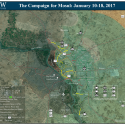 |
 |
The Campaign for Mosul: January 10-18, 2017

The Iraqi Security Forces (ISF) is rapidly consolidating control over eastern Mosul following a major push from January 10 to 18. The ISF has extended its control along the Tigris River and recaptured the University of Mosul, once ISIS’s major logistical hub in the city.
The ISF is nearing the end of operations in eastern Mosul after a major push from January 10 to 18 to recapture several remaining neighborhoods and the University of Mosul. The Counter Terrorism Service (CTS), the ISF’s elite urban warfare units, advanced two efforts to clear the University of Mosul and to extend the ISF’s control of the Tigris River. The CTS officially announced control over the university on January 15, after storming it two days prior, and continued to advance north along the river bank, seizing two additional bridges and key government buildings on January 13.
Meanwhile, the Iraqi Army (IA) and Federal Police are consolidating gains in northern and southeastern Iraq. The Iraqi Army is advancing west along Mosul’s northern city limit towards the remaining ISIS-held areas in eastern Mosul. Federal Police and Iraqi Army units announced on January 14 full control of southeastern Mosul with the recapture of Yarmjah and the southeastern countryside with the recapture of Qiz Fakhri, the last ISIS-held village on the eastern bank. The Federal Police announced the same day the completion of its mission in southeastern Mosul and that its units will return to the southern axis in order to resume efforts to break into the Mosul airport and southern military base. This effort will likely occur in synchronization as the ISF cross the Tigris River into western Mosul, though no timeline has yet been given.
Recent reinforcements and increased Coalition advisors enabled these quick advances, though it is also likely that ISIS did not resist the ISF to the same extent as in the early stages of the city battle. The destruction of the five bridges spanning the Tigris River by Coalition airstrikes has likely limited ISIS’s mobility between east and west Mosul, hurting its ability to reinforce and resupply its fighters in the east. Pentagon spokesman Capt. Jeff Davis stated on January 9 that ISIS has resorted to makeshift means, including planks and cranes, to move people and equipment into eastern Mosul. The ISF is therefore facing an enemy incapable of regenerating its ranks as it takes losses. ISIS may have already withdrawn the majority of its fighters from eastern Mosul, as well, in order to limit its casualties in the face of growing ISF momentum.
ISF operations in western Mosul will require a change in tactic. The block-by-block method of clearing eastern Mosul will not be effective in the west because its infrastructure is not laid out by city blocks. ISIS will use western Mosul’s narrow and winding streets to challenge less-experienced ISF units, such as the Iraqi Army. The group may rely more on the city’s infrastructure for static defenses, as it did in Ramadi, in order to stave of its immediate loss of the city. Lessons learned from eastern Mosul, however, such as the need for cross-axis coordination, will help the ISF rebuff ISIS’s defenses and ensure that operations in western Mosul are smoother than the stop-and-go progress that protracted operations in the east.